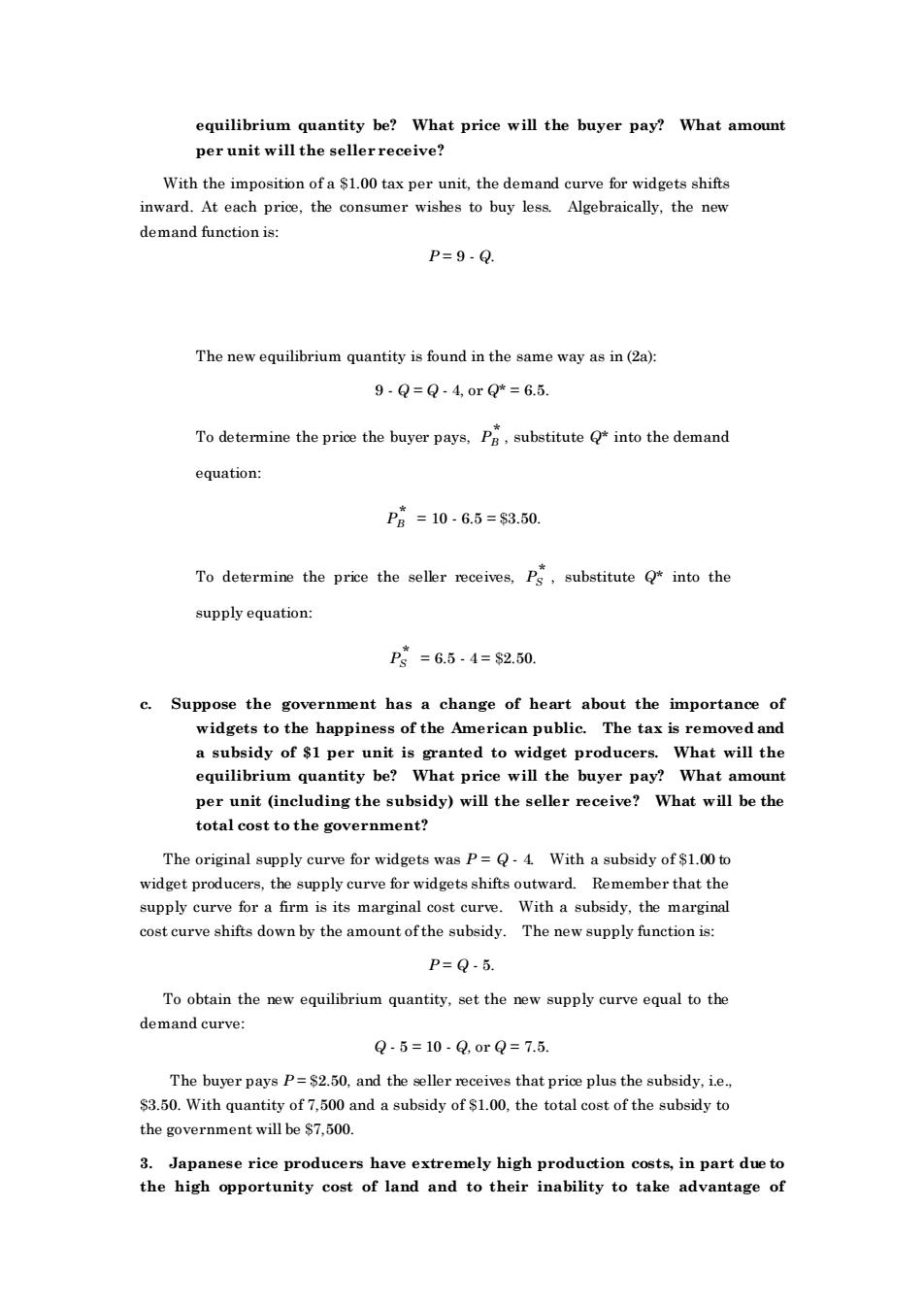正在加载图片...

equilibrium quantity be?What price will the buyer pay?What amount per unit will the sellerreceive? With the imposition of tax per unit,the demand curveor widgets shifts inward.At each price.the consumer wishes to buy ess Algebraically,the now demand function is: P=9.Q The new equilibrium quantity is found in the same way as in(2a): 9.Q=Q-4orQ*=6.5. To determine the price the buyer pays P,substituteinto the demand equation: P=10.6.5=3.50 To determine the price the seller receives,Ps,substitute into the supply equation: P=6.54=$2.50. Suppose the govm of heart about the importance of widgets to the erican public. The tax is remove ed and a subsidy of $1 per unit is granted to widget producers.What will the equilibrium quantity be? What price will the buyer pay?What amount per unit (including the subsidy)will the seller receive?What will be the total cost to the government? The original supply curve for widgets wasP=Q4 With a subsidy of e supply curve fo Rememb er that th With a subsidy,the margina cost curve shifts down by the amount ofthe subsidy.The new supply function is: P=Q.5. To obtain the new equilibrium quantity,set the new supply curve equal to the demand curve: Q.5=10.Q.0rQ=7.5 The buyer pays P=$250,and receives that price plus the subsidy,ie $.50.With and a subsidy of $100.the otal cos of the subsidy to the government will be $7,50 3.Japanese rice producers have extremely high production costs,in part due to the high opportunity cost of land and to their inability to take advantage of equilibrium quantity be? What price will the buyer pay? What amount per unit will the seller receive? With the imposition of a $1.00 tax per unit, the demand curve for widgets shifts inward. At each price, the consumer wishes to buy less. Algebraically, the new demand function is: P = 9 - Q. The new equilibrium quantity is found in the same way as in (2a): 9 - Q = Q - 4, or Q* = 6.5. To determine the price the buyer pays, PB * , substitute Q* into the demand equation: PB * = 10 - 6.5 = $3.50. To determine the price the seller receives, PS * , substitute Q* into the supply equation: PS * = 6.5 - 4 = $2.50. c. Suppose the government has a change of heart about the importance of widgets to the happiness of the American public. The tax is removed and a subsidy of $1 per unit is granted to widget producers. What will the equilibrium quantity be? What price will the buyer pay? What amount per unit (including the subsidy) will the seller receive? What will be the total cost to the government? The original supply curve for widgets was P = Q - 4. With a subsidy of $1.00 to widget producers, the supply curve for widgets shifts outward. Remember that the supply curve for a firm is its marginal cost curve. With a subsidy, the marginal cost curve shifts down by the amount of the subsidy. The new supply function is: P = Q - 5. To obtain the new equilibrium quantity, set the new supply curve equal to the demand curve: Q - 5 = 10 - Q, or Q = 7.5. The buyer pays P = $2.50, and the seller receives that price plus the subsidy, i.e., $3.50. With quantity of 7,500 and a subsidy of $1.00, the total cost of the subsidy to the government will be $7,500. 3. Japanese rice producers have extremely high production costs, in part due to the high opportunity cost of land and to their inability to take advantage of